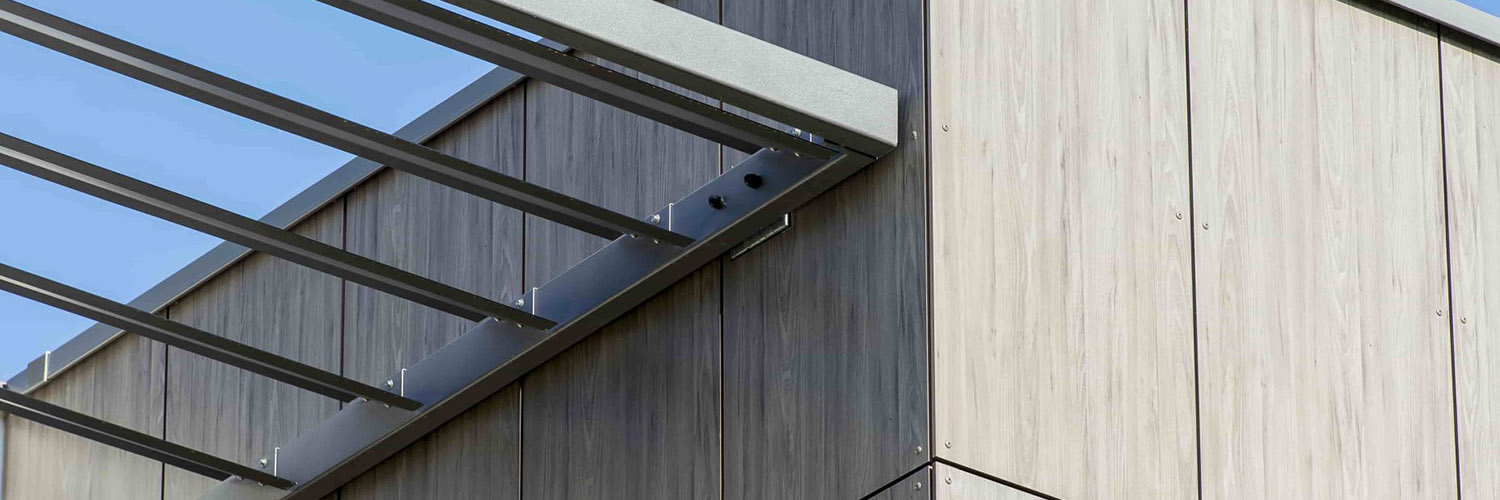MEG – MATERIAL EXTERIOR GRADE
MEG is a construction product that is ideal for architecture and comprises a rigid core combined with a decorative surface consisting of weather-resistant thermosetting resins. Solid, compact and long-lasting, MEG is specifically designed for outdoor application; it is resistant to natural weathering (sunlight and atmospheric agents) providing technical performances that make it suitable to the building sector, where it represents an excellent alternative to traditional materials.

MEG is available in a wide range of decors and can be customised thanks to digital printing technique that allows you to create a resistant wall cladding with a “customised skin”, which can also be implemented based on your drawing (graphic perspective) or photograph.
SPECIFIC CHARACTERISTICS
MEG is a high-pressure decorative laminate for external applications, consisting of layers of cellulose fibres impregnated with thermosetting phenolic resins and of one or more surface layers of decorative paper impregnated with thermosetting resins having a special weather protection, all chemically bonded together by a high pressure process as described in the EN 438:2005 – 6 standard.
MAIN APPLICATIONS
MEG is mainly used for cladding façades (typically rainscreens) and balconies, as well as for sunscreens, street furniture and outdoor signage.
RAINSCREENS
A rainscreen is a building system that consist in the creation of a cavity with natural ventilation between the load-bearing structure with external insulation and the cladding. MEG panels provide resistance to atmospheric agents (sun, rain, snow, heat, frost, etc.).

FIXING OF THE PANELS
Provided that the panels have always to be assembled with the proper air gap on the back side, those must be never mounted too close together: always allow for a degree of clearance by means of an expansion gap, the size of which can be calculated according to the dimensions of the wall covering panels.
MEG contracts in low humidity and expands in high humidity environments. To achieve optimum assembly, you should always taking into account “fixed” and “sliding” points having different hole diameters in order to allow the dilatation. The screw must have flat head, never embed, as this will interfere with the expansion of the material.
Fixing systems for ventilated façades:
› “Visible” fixing on aluminium substructure
› “Visible” fixing on wooden substructure
› Invisible fixing: split batten on aluminium substructure
› Invisible fixing: adhesive on aluminium substructure
› Invisible fixing: adhesive on wooden substructure
All the details related to the fixing of the panels are in the dedicated MEG Technical Manual.
PROPERTIES
- Fluctuations in temperature and relative humidity do not affect the physical and mechanical properties of MEG.
- Before use, it is recommended to store the panels in a well-supported and ventilated position in order to allow acclimatisation and prevent any deformation.
- The particular compactness of MEG ensures an optimal combination of mechanical characteristics such as flexural and tensile strength, compression and impact resistance. The homogeneity and high density of the panels provides high resistance to extraction of the fastening elements.
- A high percentage of the raw materials used for the production of MEG comes from renewable sources.

EASY MEG
EASY MEG is the easy and ready to use system for the realisation of external facades.
The EASY MEG system gives buildings a sophisticated and long-lasting elegance, thanks to smooth surfaces and intense colours. This facade solution is designed to be durable, easy to install and low maintenance.
EASY MEG system is designed to remain unchanged over time.
Rain, salt, wind, humidity, intense sunlight: EASY MEG withstands elements, maintaining its main decorative features and physical properties. The surface of EASY MEG does not require painting or any specific cleaning.
The material used for EASY MEG F1 complies with the performance requirements of EN 438-6:2016.
EASY MEG consists of three different fixing systems: Closed Joint, Open Joint and Overlapping.

